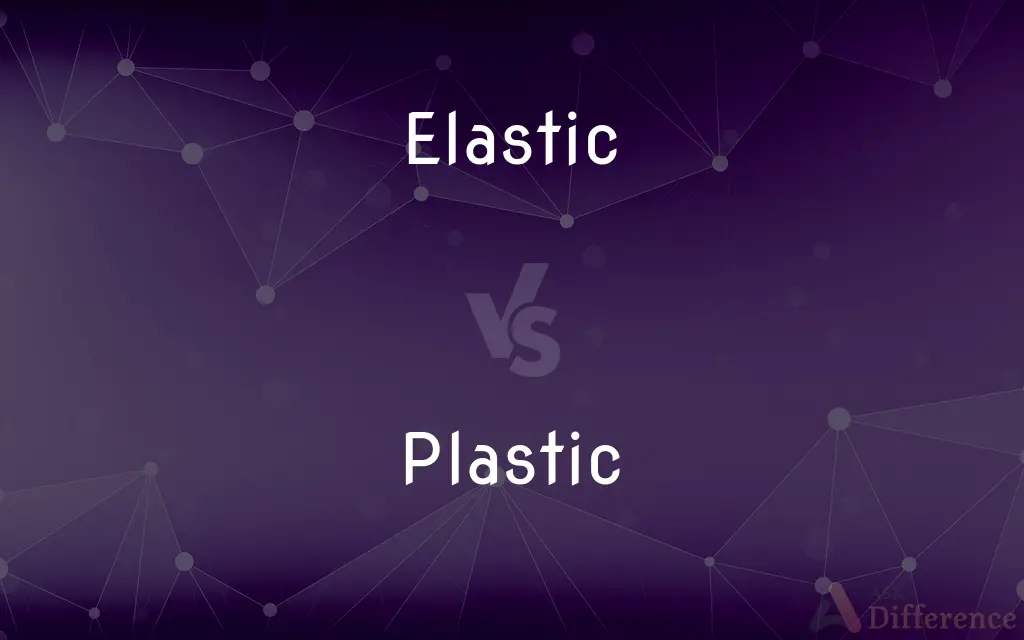Elastic vs. Plastic — What's the Difference?
By Urooj Arif & Maham Liaqat — Updated on March 15, 2024
Elastic deformation is reversible, allowing materials to return to their original shape after stress, while plastic deformation is permanent, altering the material's shape permanently under stress.

Difference Between Elastic and Plastic
Table of Contents
ADVERTISEMENT
Key Differences
Elastic deformation occurs when a material is subjected to a force that causes it to stretch or compress, but upon removal of the force, the material returns to its original shape. This behavior is characterized by the material's ability to absorb energy and release it upon unloading, like a rubber band stretching and then returning to its shape. Whereas, plastic deformation refers to a permanent change in the shape of a material when a force exceeds a certain threshold, leading to a rearrangement of the material's internal structure. Unlike elastic deformation, once the force is removed, the material does not return to its original shape, as seen in the bending of a metal spoon.
The distinction between elastic and plastic deformation is fundamental in materials science and engineering, determining the suitability of materials for various applications. Materials that exhibit significant elastic behavior are preferred in applications requiring flexibility and resilience, such as springs and elastic bands. On the other hand, materials that undergo plastic deformation are useful in forming processes, like forging and stamping, where a permanent change in shape is desired.
The transition from elastic to plastic deformation is marked by the yield point in many materials. Up to this point, deformation is mainly elastic, and the material can recover. Beyond the yield point, plastic deformation begins, and the material will not return to its original shape. This concept is critical in designing structures and components to ensure they operate within the elastic range to avoid permanent deformation or failure.
Both types of deformation involve different mechanisms at the atomic or molecular level. Elastic deformation is mainly due to the stretching of bonds between atoms within the material, which can return to their original state after the stress is removed. Plastic deformation, however, involves the movement of dislocations and the permanent sliding of planes of atoms past each other, leading to a lasting change in the material's structure.
While elastic materials are often associated with substances like rubber or springy metals, many materials can exhibit both elastic and plastic behaviors under different conditions. The choice between using materials that exhibit predominantly elastic or plastic characteristics depends on the specific requirements of the application, including strength, flexibility, and durability.
ADVERTISEMENT
Comparison Chart
Reversibility
Reversible upon removing stress
Permanent, irreversible change
Energy
Energy absorbed is fully recoverable
Energy absorbed leads to permanent change
Application Examples
Springs, rubber bands
Forged metal parts, molded plastics
Mechanism
Stretching of bonds between atoms
Movement of dislocations, atom planes
Yield Point
Deformation is elastic up to this point
Deformation becomes plastic beyond this
Material Behavior
Returns to original shape
Does not return to original shape
Use in Design
Preferred for flexible, resilient applications
Used in forming, shaping processes
Compare with Definitions
Elastic
Material behavior under low stress.
The elastic deformation of the spring ensures it springs back.
Plastic
Permanent deformation under stress.
The plastic deformation of clay allows it to be molded into shapes.
Elastic
Characterized by reversibility.
Elastic fabrics are ideal for clothing due to their ability to stretch and recover.
Plastic
Involving dislocation movement.
Plastic deformation in metals involves the sliding of atomic planes.
Elastic
Capable of returning to original shape.
The elastic band stretched and then returned to its original form.
Plastic
Used in shaping processes.
Plastic deformation techniques include forging and stamping metals.
Elastic
Absorbing and releasing energy.
Elastic materials like rubber absorb energy when stretched.
Plastic
Beyond the yield point.
Once metal exceeds its yield point, it undergoes plastic deformation.
Elastic
Within the yield point.
Materials under elastic deformation do not suffer permanent changes.
Plastic
Irreversible material change.
Bending a plastic spoon results in a permanent change in shape.
Elastic
Easily resuming original size or shape after being stretched or otherwise deformed; flexible.
Plastic
Plastics are a wide range of synthetic or semi-synthetic materials that use polymers as a main ingredient. Their plasticity makes it possible for plastics to be moulded, extruded or pressed into solid objects of various shapes.
Elastic
Relating to a collision in which the total kinetic energy is conserved.
Plastic
A synthetic material made from a wide range of organic polymers such as polyethylene, PVC, nylon, etc., that can be moulded into shape while soft, and then set into a rigid or slightly elastic form
Mains pipes should be made of plastic or copper
Bottles can be made from a variety of plastics
Elastic
Quick to recover, as from disappointment; resilient
An elastic spirit.
Plastic
Made of plastic
Plastic bottles
Elastic
Capable of being adapted to change or a variety of circumstances
"To say that morale is a highly unscientific and quite elastic concept would be an understatement" (Roger J. Spiller).
Plastic
(of a substance or material) easily shaped or moulded
Rendering the material more plastic
Elastic
(Economics) Of, relating to, or being a good for which changes in price have a large effect on the quantity demanded or supplied.
Plastic
Capable of being shaped or formed
Plastic material such as clay.
Elastic
A flexible stretchable fabric made with interwoven strands of rubber or an imitative synthetic fiber.
Plastic
Relating to or dealing with shaping or modeling
The plastic art of sculpture.
Elastic
An object made of this fabric.
Plastic
Having the qualities of sculpture; well-formed
"the astonishing plastic beauty of the chorus girls" (Frank Harris).
Elastic
A rubber band.
Plastic
Giving form or shape to a substance
The plastic forces that create and wear down a mountain range.
Elastic
Capable of stretching; particularly, capable of stretching so as to return to an original shape or size when force is released.
The rope is somewhat elastic, so expect it to give when you pull on it.
Plastic
Easily influenced; impressionable
"The plastic mind of the bank clerk had been ... distorted by what he had read" (Rudyard Kipling).
Elastic
Made of elastic.
Elastic band
Plastic
Made of a plastic or plastics
A plastic garden hose.
Elastic
Of clothing, elasticated.
Plastic
(Physics) Capable of undergoing continuous deformation without rupture or relaxation.
Elastic
(economics) Sensitive to changes in price.
Demand for entertainment is more elastic than demand for energy.
Plastic
Capable of building tissue; formative.
Elastic
Springy; bouncy; vivacious
Plastic
Able to change and adapt, especially by acquiring alternative pathways for sensory perception or motor skills. Used of the central nervous system.
Elastic
Pervasive, all-encompassing.
Plastic
Marked by artificiality or superficiality
A plastic world of fad, hype, and sensation.
Elastic
Able to return quickly to a former state or condition, after being depressed or overtaxed; having power to recover easily from shocks and trials.
Elastic spirits; an elastic constitution
Plastic
(Informal) Of or obtained by means of credit cards
Plastic money.
Elastic
(uncountable) An elastic material used in clothing, particularly in waistbands and cuffs.
Running shorts use elastic to eliminate the need for a belt
Plastic
Any of various organic compounds produced by polymerization, capable of being molded, extruded, cast into various shapes and films, or drawn into filaments used as textile fibers.
Elastic
(countable) An elastic band.
Plastic
(Informal) A credit card or credit cards
Would accept cash or plastic in payment.
Elastic
Springing back; having a power or inherent property of returning to the form from which a substance is bent, drawn, pressed, or twisted; springy; having the power of rebounding; as, a bow is elastic; the air is elastic; India rubber is elastic.
Capable of being drawn out by force like a piece of elastic gum, and by its own elasticity returning, when the force is removed, to its former position.
Plastic
A synthetic, solid, hydrocarbon-based polymer, whether thermoplastic or thermosetting.
Elastic
Able to return quickly to a former state or condition, after being depressed or overtaxed; having power to recover easily from shocks and trials; as, elastic spirits; an elastic constitution.
Plastic
Credit or debit cards used in place of cash to buy goods and services.
Elastic
An elastic woven fabric, as a belt, braces or suspenders, etc., made in part of India rubber.
Plastic
Insincerity; fakeness, or a person who is fake or arrogant, or believes that they are better than the rest of the population.
Elastic
A narrow band of elastic rubber used to hold things (such as papers) together
Plastic
An instance of plastic surgery.
Elastic
An elastic fabric made of yarns containing an elastic material
Plastic
(obsolete) A sculptor, moulder.
Elastic
Capable of resuming original shape after stretching or compression; springy;
An elastic band
A youthful and elastic walk
Plastic
(archaic) Any solid but malleable substance.
Elastic
Able to adjust readily to different conditions;
An adaptable person
A flexible personality
An elastic clause in a contract
Plastic
Capable of being moulded; malleable, flexible, pliant.
Plastic
Producing tissue.
Plastic
(dated) Creative, formative.
Plastic
(biology) Capable of adapting to varying conditions; characterized by environmental adaptability.
Plastic
Of or pertaining to the inelastic, non-brittle, deformation of a material.
Plastic
Made of plastic.
Plastic
Inferior or not the real thing.
Plastic
Fake; insincere.
Plastic
Having the power to give form or fashion to a mass of matter; as, the plastic hand of the Creator.
See plastic Nature working to his end.
Plastic
Capable of being molded, formed, or modeled, as clay or plaster; - used also figuratively; as, the plastic mind of a child.
Plastic
Pertaining or appropriate to, or characteristic of, molding or modeling; produced by, or appearing as if produced by, molding or modeling; - said of sculpture and the kindred arts, in distinction from painting and the graphic arts.
Medallions . . . fraught with the plastic beauty and grace of the palmy days of Italian art.
Plastic
A substance composed predominantly of a synthetic organic high polymer capable of being cast or molded; many varieties of plastic are used to produce articles of commerce (after 1900). [MW10 gives origin of word as 1905]
Plastic
Generic name for certain synthetic or semisynthetic materials that can be molded or extruded into objects or films or filaments or used for making e.g. coatings and adhesives
Plastic
Used of the imagination;
Material...transformed by the plastic power of the imagination
Plastic
Capable of being molded or modeled (especially of earth or clay or other soft material);
Plastic substances such as wax or clay
Plastic
Capable of being influenced or formed;
The plastic minds of children
A pliant nature
Common Curiosities
Can a material exhibit both elastic and plastic deformation?
Yes, many materials can exhibit both behaviors under different conditions or levels of stress.
How is plastic deformation used in manufacturing?
It's used in processes like forging, stamping, and molding to permanently shape materials.
What is the difference between elastic and plastic deformation?
Elastic deformation is reversible, allowing materials to return to their original shape after stress, while plastic deformation results in permanent changes to the material's shape.
Can plastic deformation occur in all materials?
Most materials can undergo plastic deformation under sufficient stress, but the conditions and stress levels required vary widely.
How do materials recover from elastic deformation?
They recover by the elastic forces within the material pulling atoms back to their original positions once the external stress is removed.
What happens at the molecular level during elastic deformation?
Bonds between atoms stretch but do not break, allowing the material to return to its original shape when stress is removed.
What determines whether deformation is elastic or plastic?
The level of applied stress relative to the material's yield point determines whether the deformation is elastic or plastic.
Why is understanding elastic and plastic deformation important in engineering?
It's crucial for designing structures and components that are safe, durable, and function as intended without undergoing permanent deformation.
How does temperature affect elastic and plastic deformation?
Temperature can influence the material's ability to deform elastically or plastically, often making materials more susceptible to plastic deformation at higher temperatures.
Why is elastic deformation preferred for some applications?
It's preferred for applications requiring materials to absorb energy and return to their original shape, such as in springs and shock absorbers.
Can plastic deformation be reversed?
No, plastic deformation is permanent and cannot be reversed by simply removing the applied stress.
What is the yield point in the context of deformation?
It's the stress level at which a material begins to deform plastically after undergoing elastic deformation.
What role do dislocations play in plastic deformation?
Dislocations facilitate the movement of atomic planes, enabling the material to deform permanently.
What happens at the molecular level during plastic deformation?
Dislocations move, and planes of atoms slide past each other, resulting in a permanent change in the material's structure.
How do engineers ensure structures remain within the elastic range?
By calculating stress levels and choosing materials with suitable yield points to prevent permanent deformation.
Share Your Discovery

Previous Comparison
Tense vs. Intense
Next Comparison
Dangerous vs. DangerAuthor Spotlight
Written by
Urooj ArifUrooj is a skilled content writer at Ask Difference, known for her exceptional ability to simplify complex topics into engaging and informative content. With a passion for research and a flair for clear, concise writing, she consistently delivers articles that resonate with our diverse audience.
Co-written by
Maham Liaqat















































